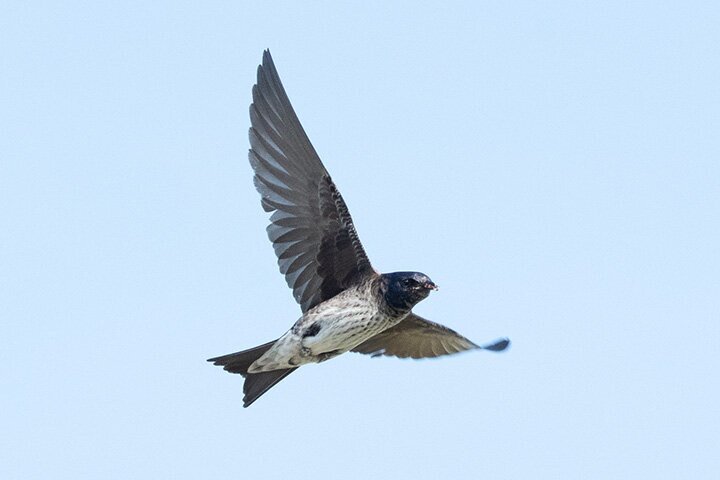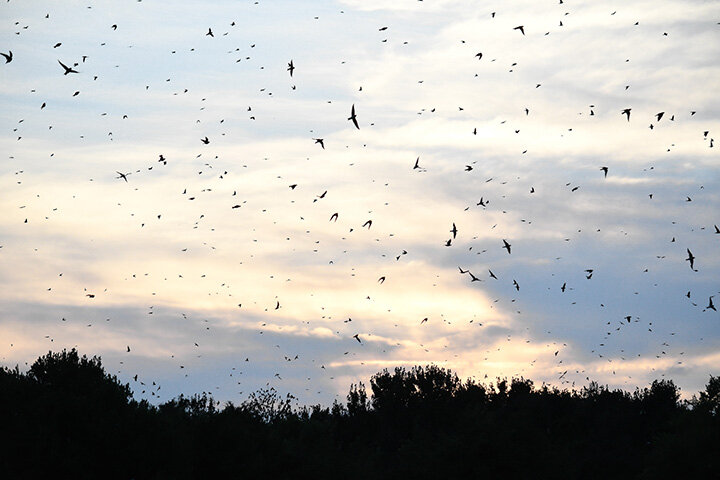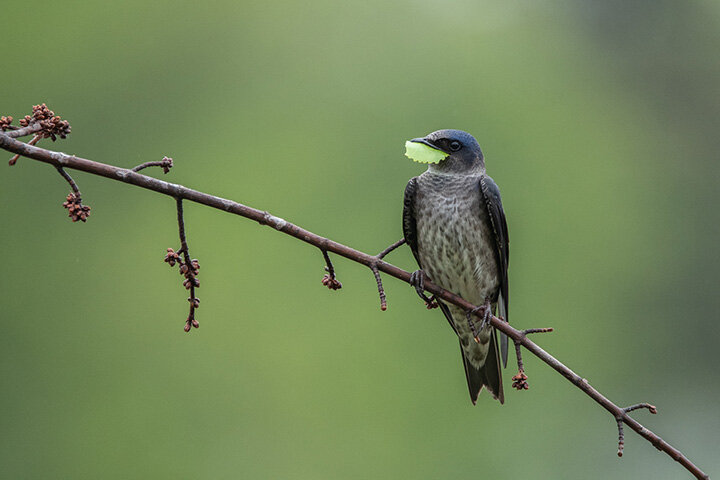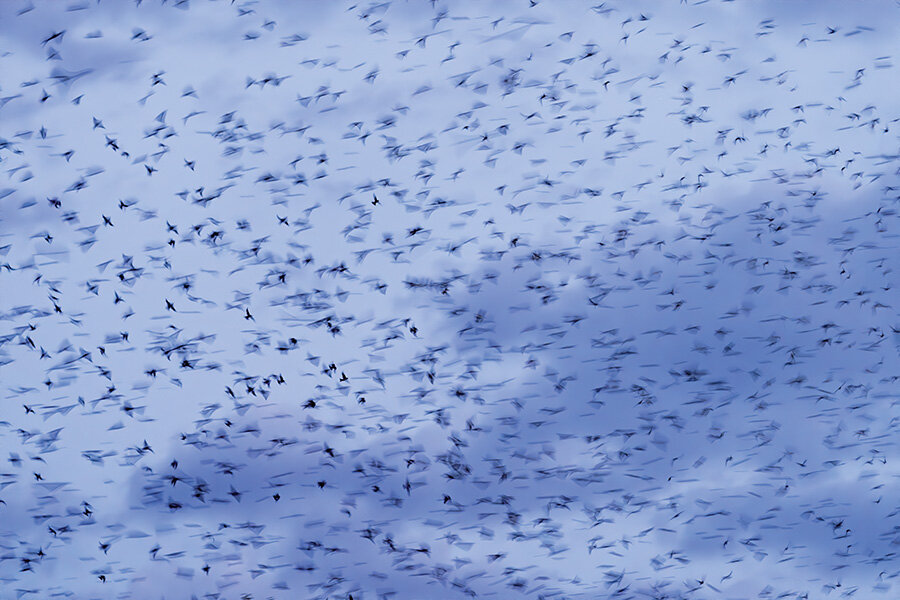For Purple Martins’ Majesties
“Wanna go see the Martins?” That’s a question I loved to hear my dad ask during the summer while growing up on the south side of Lake Murray. It reminds me of all the small things you don’t know are special when you’re young, like taking the folding chairs out to the boat (the only permanent chair on our pontoon boat, which we named “Tin Can,” was my father’s “Captain’s” chair.) It reminds me of mom’s snack mix loaded with nuts and those slightly burnt bits of rice Chex that were lucky enough to soak up some of the butter in which they were cooked. It reminds me of boat-created summer breezes, orange Chek soda, and those unforgettable and unbeatable Lake Murray Sunsets (which are indeed, fyi, totally worthy of capital letters.) And then, of course, I’m reminded of the frenetic bird tornado the Purple Martins create when they congregate each evening at Bomb Island. What a sight! Isn’t it amazing that all those memories were created because of a bird? That is just one example of the power of nature, and our much-needed connection to it.
Photo by Zach Steinhauser
But the Purple Martin isn’t just any bird. It’s a fast flying, insect eating, cavity nesting, transcontinental migrating, purple-fighter-jet of a bird. Visually, the male Purple Martin is a stunning bluish-purple, but you’ll need a good pair of binoculars to pull out the vibrant colors of the bird, which are at their brightest when reflecting the sun’s light. The female and young males are brown, though young males can have purple feathers on their chest and belly. Purple Martins are the largest member of the swallow family here in North America, and measure about 7.5 inches in length, have a 15–16-inch wingspan, and an average weight of 1.97 ounces.
This photo and cover photo by Vance Solseth
Although the purple color and size make this bird standout, there are several other species in our area that are Purple Martin lookalikes, at least from a distance. Northern Rough-winged Swallows, gorgeous green and white Tree Swallows, fancy flying Barn Swallows, and even Chimney Swifts can all be confused with Purple Martins. The social birds you see when driving a boat under a bridge on Lake Murray are Cliff Swallows, another member of the swallow family that build their gourd shaped nests out of mud. These other swallows and swifts also migrate here from the tropics to take advantage of the surge of insects we have during our spring and summer.
Photo by Zach Steinhauser
Now that we know what the Purple Martin looks like, let’s talk about how and where to find these beauties. I have a silly saying during my SCWF bird classes that goes, “you won’t see what you don’t see, but you might see what you hear.” The mechanical chortling, clicking, and buzzing sounds of the Purple Martin scream; “It’s summertime in South Carolina!” and are a strange and pleasing addition to our hottest time of year, especially while that hot weather is being enjoyed via dock or boat. (Beverage optional. No, have the beverage!) If you’ve never seen a Purple Martin, learn its calls and song and they’ll tell you exactly where they are, or you can simply go to one of the many gourd racks people have installed around the lake, or local pastures to find them during the spring and summer.
Photo by Zach Steinhauser
In late summer, the adults and newborns create huge flocks and roosts, typically around isolated and safe areas, such as islands with thick understory, just like Bomb Island provides. These roosts can contain tens or hundreds of thousands of birds, and can be quite breathtaking, especially when combined with a sunset that is equally as breathtaking. If you’ve never seen the Purple Martin roost on Lake Murray I strongly urge you to do it. It’s awe inspiring, freeing, and provides one of those rare moments in life that makes you feel you're a part of something wild and more expansive than the very human world we’ve created, which can sometimes make us feel a bit confined and restricted. When you’re out there, take note too, of the reactions of people in boats around you. For me, it’s almost as satisfying to see and hear adults react like excited children as it is to see such a marvelous natural spectacle. It gives me hope that humans and wildlife can live side by side in our ever-developing world.
To help educate the public and generate love for this superstar bird, local conservationist, photographer, and filmmaker, Zach Steinhauser, has been working on a Purple Martin documentary – appropriately named “Purple Haze”– over the last four years. As a conservationist and naturalist he wants to share the birds’ amazing story with the public and bring awareness of the challenges they face throughout the year on their breeding grounds in North America, as well as their wintering grounds in South America.
The film has taken Zach from SC to LA, PA, AZ, and even to Brazil, as he unfolded the story of this birds’ amazing year long journey which begins along the Amazon basin during our winter, and ends at its nesting territory across much of our continent during the summer.
Zach tells the story of how the bird historically nested in natural cavities within our huge eastern forests, but as America was settled and developed, the birds began using man-made structures that were being installed at residences and businesses across the east. There are even historical records of Native Americans setting up gourds for the Purple Martins! Due to a combination of habitat loss and the installation of so many man-made residences, the Purple Martin almost nests entirely in homes created by humans now, at least on the eastern half of the U.S. They still mostly use natural cavities in the west, especially in the desert of Arizona where cavities are often found in saguaro cacti. With having his own Purple Martin-like travels behind him, Zach hopes to premiere his documentary later this year as he nears the completion of this epic journey. If you’re interested in watching this film, the SC Wildlife Federation will advertise this wonderful conservation accomplishment when the date is chosen for the premiere. Or check out to purplehazeacfmovie.com to learn more about Zach's film.
Photo by Zach Steinhauser
Even though the Purple Martin is common around Lake Murray, the species has declined approximately 37 percent over the last 50 years according to the Cornell Lab of Ornithology. However, by installing nesting racks in the appropriate areas, growing/installing native plants that support insects such as butterflies and moths; and keeping your water clean and free of chemicals which will then support a healthy population of dragonflies and damselflies, you can do your part in helping this bird thrive in our modern world. If you’re interested in learning more about Purple Martins, as well as other birds in our area, please visit: All About Birds. You will be able to practice the sounds they make, as well as learn about the different foods they prefer (mosquitos are not on the list) and find out about the additional challenges these and other birds face in our modern world.
And if you don’t have a boat, and don’t know anyone on the lake that can take you to Bomb Island during the summer roosting period, there is a local tour company, Lake Murray Yacht Tours, that can make this bucket list experience a reality for you.
Thank you again for taking the time to read more about the wild beyond your window! Please be safe in and around the lake this summer, and keep your eyes open to all the wild wonders our natural areas contain.
















